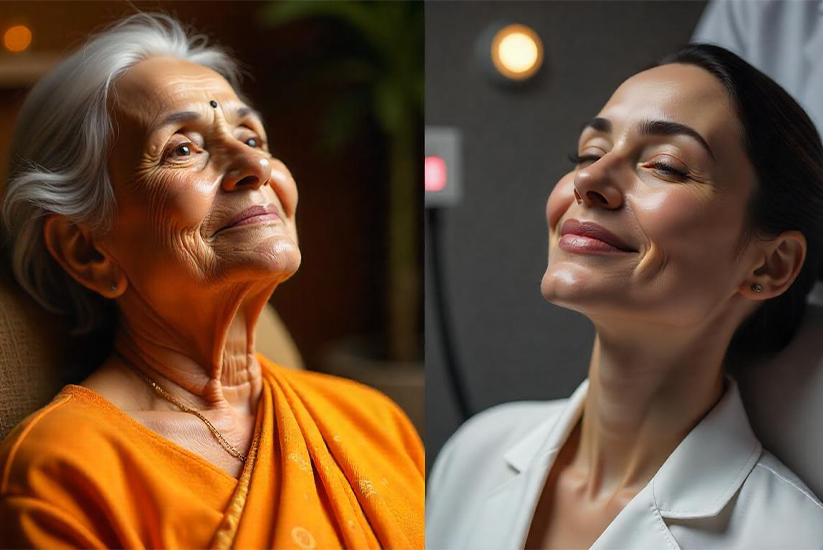Ayurveda vs Modern Anti Aging Treatments: What Works Best for Indian Skin?
- April 29, 2025
- Posted by: admin

Aging is a given, but how we experience it – especially through our skin – can vary greatly, depending on many things including our genes, our environment, and our skincare choices. When we see advertisements claiming “anti-aging” on products, not much differentiation has been made for Indian skin’s unique relationship to pigmentation, namely because it has a bigger reservoir of melanin. With Indian skin’s color range comes Asian skin’s considerable risk of pigmentation issues. When treating or trying to prevent pigmentation on Indian skin, getting a pathway set for treatment may mean making choices with the efficacy of the products, treatments, or their order in mind.
Now, I’m not in any position to stop you from choosing the wrong treatment, but in recent years I have become aware of two teams vying for dominance in this space; Ayurveda and anti-aging. One summed up in thousands of years of natural healing traditions; the other involving science, technology, and clinical specificity.What matters most for Indian skin? Let’s take a look.
In comparing Ayurveda vs Modern Best Anti-Aging Treatments for Indian skin, the answer is not black and white. There are many shades of gray that depend on your skin type, lifestyle, goals, and sensitivities. Let us talk about both options so we can understand what works best in an Indian setting!
Ayurveda: For Specific Skin-Type
Advantages:Custodianship of Indian skin and climate: Because of Dosha (i.e. Vata, Pitta and Kapha), Ayurveda makes very individualized care specifically for skin that is usually melanin-heavy and more prone to pigmentation.
Natural products: Natural ingredients (ashwagandha, manjistha, aloe vera, and turmeric) all potentially help lower inflammation and promote radiance.
No harsh chemical products on skin: This minimizes the risk of reactions or long-term skin barrier dysfunction.
Long-term health and well-being: Integrates diet, yoga, detoxification, sleeping and stress management.
Con:
Slow results: The process is time-consuming and requires consistency.
No clinical studies: Your evidence is anecdotal/traditional.
Quality of product: Product can vary quite a bit – purity and formulation can make a great deal of difference.
Best for:
- Sensitive skin
- Hyperpigmentation
- Early signs of aging (dullness, uneven skin tone)
- Long term glowing and healthy skin.
Modern Anti-Aging Treatments: Fast & Scientific
Pros:
Rapid outcomes – Retinoids, peptides, hyaluronic acid, and other clinical treatments (such as lasers, microneedling, Botox) can provide the quickest results.
Targeted – Can eliminate deep wrinkles, sagging, or volume loss.
Clinically proven – backed by studies/research conducted by dermatologists.
Cons:
The heightened melanin levels in Indian skin make it exceptionally susceptible to post-inflammatory hyperpigmentation (PIH).
Many treatments require follow-up sessions which makes them costly and difficult to maintain.
Potential adverse effects may occur when performed without proper skill or knowledge of Indian skin characteristics.
Best for:
- Deep wrinkles or volume loss
- Sun damage
- Fast transformation (e.g., pre-wedding or event prep)
- People comfortable with actives or in-office treatments
What works best for Indian Skin?
The simultaneous application of both elements frequently produces optimal outcomes:
The foundational principles of Ayurvedic skincare (cleansing, detoxification, internal equilibrium)
Contemporary dermatological science enables specific treatments through advanced anti-aging compounds and specialized procedures.
Ideal Routine Example of Indian Skin:
Morning: Apply Ayurvedic cleanser followed by Vitamin C serum and finish with sunscreen
Evening: Ayurvedic oil massage,
Apply retinol/peptide cream two to three times weekly.
Monthly: Herbal facials and mild clinical peels
Which One is Best: Modern or Ayurvedic?
Contemporary anti-aging is ideal for rapid outcomes and profound repair.
Ayurvedic anti-aging is best suited for natural care and prevention.
The ideal strategy? A wise combination of both: apply Ayurvedic methods for daily equilibrium and skin well-being, and contemporary treatments judiciously for deeper issues.
The Ideal Solution? A Balanced Approach
The best anti-aging solution for the contemporary Indian woman may be a combination of science and tradition:
Apply Ayurveda to everyday skincare, stress management, and internal equilibrium.
Select modern treatments judiciously for deep wrinkles, sagging, or persistent pigmentation—under professional guidance.
Which one is more gentle on skin?
The answer? Both have their place—and the smartest choice might be a mix of the two.
Indian and melanin-rich skin types often react to harsh treatments or activities. Ayurveda uses chemical-free, plant-based solutions, which are ideal for sensitive or reactive skin. It’s also pregnancy-safe and suitable for women who avoid synthetic products.
Final Thoughts
Both Ayurveda and contemporary skincare have useful contributions to make to the anti-aging process—particularly to Indian skin, which needs both feeding and safeguarding. Ayurveda provides tried-and-true, gentle care for long-term skin wellness, while contemporary therapies offer the quick-acting, science-based solutions we tend to need in our busy modern lives.
The secret is knowing your skin’s specific needs and making a custom blend that matches your lifestyle, age, and desire.
If you’re just getting started, consider speaking to both an Ayurvedic practitioner and a dermatologist to build a holistic, sustainable anti-aging routine—because when tradition and science work together, your skin wins.
